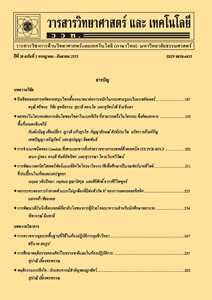A สภาวะแวดล้อมมหภาคของอุตสาหกรรมอิเล็กทรอนิกส์ไทยภายใต้ยุทธศาสตร์การพัฒนาอุตสาหกรรมไทย 4.0
Main Article Content
Abstract
This research aims to study the macroeconomic environment of the Thai electronics industry under the policy of industry 4.0 using the PESTEL analysis. After that, survey research was conducted specifically for the electronics industry with a total of 273 companies, which were registered with the institute of electrical and electronics industry. Each company was submitted questionnaires to three divisions, i.e. manufacturer, design manager, and production manager. The 510 questionnaires from 170 companies were returned. The size of the samples was analyzed according to Taro Yamane’s theory with the confidence level of 95 %. The result found that small Thai enterprises in the electronic industry focuses the most on technology factors, especially wireless security technology and promotion technology in the production process. The legal factors related to intellectual property protection for manufacturing and design were discussed. For the environmental factors, manufacturers need environmentally friendly technology and innovation. Finally, economic factors, manufacturers look at the global economic fluctuations.
Article Details
References
Chaijaroen Tech Co., Ltd., The 4th Industrial Revolution the Importance of the New Age Revolution, Available Source: https://www.chi.co.th/article/article-966, November 9, 2018. (in Thai)
Ministry of Foreign Affairs of the Kingdom of Thailand, A Practical Approach Toward Sustainable Development, Available Source: https://www.mfa.go.th/SEPforSDGs/APracticalApproachtowardSustainableDevelopment/A_Practical_Approach_toward_Sustainable_Development.pdf, November 12, 2016. (in Thai)
Electrical and Electronics Institute, Product Trends and Exports in 2018, Available Source: https://eiu.thaieei.com/box/Research/25/forc.Q-EX2018.pdf, December 1, 2018. (in Thai)
Yongpisanphob, W., Thailand Industry Outlook 2018-20 (Electrical Appliances), Retrieved from https://www.krungsri.com/bank/getmedia/110bd88f-bb27-422c-a8c8-7289b6e52b74/IO_Electrical_ Appliances_180907_EN_EX.aspx, November 3, 2018. (in Thai)
Yu, C., Ma, X., Fang, F., Qian, K., Yao, S. and Zou, Y., 2017, Design of controller system for industrial robot based on RTOS Xenomai, In Industrial Electronics and Applications (ICIEA), IEEE Conference 12: 221-226.
Song, J., Sun, Y. and Jin, L., 2017, PESTEL analysis of the development of the waste-to-energy incineration industry in China, Renew. Sustain. Energy Rev. 80: 276-289.
Rahman, N.A., Saharuddin, A.H. and Rasdi, R., 2014, Effect of the northern sea route opening to the shipping activities at Malacca straits, Int. J. e-Navigat. Marit. Econ. 1: 85-98.
Damian, D. and Moitra, D., 2006, Guest editors' introduction: Global software development: How far have we come?, IEEE software 23(5): 17-19.
Rice, P.L. and Ezzy, D., 1999, Qualitative research methods: A health focus, Vol. 720, Victoria Australia Oxford 21(3): 93-141.
Cooper, D.R., Schindler, P.S. and Sun, J., 2006, Business Research Methods, Vol. 9, McGraw-Hill Irwin, New York.
Rovinelli, R.J. and Hambleton, R.K., 1977, On the use of content specialists in the assessment of criterion referenced test item validity, Dutch J. Edu. Res. 2: 49-60.
Yamane, T., 1973, Statistics: An Introductory Analysis, 3rd Ed., Harper International Edition, New York.
Feser, E., Sweeney, S. and Renski, H., 2005, A descriptive analysis of discrete US industrial complexes, J. Reg. Sci. 45: 395-419.
Wijngaarden, J.D., Scholten, G.R. and van Wijk, K.P., 2012, Strategic analysis for health care organizations: The suitability of the SWOT-analysis, Int. J. Health Planning Manag. 27(1): 34-49.


